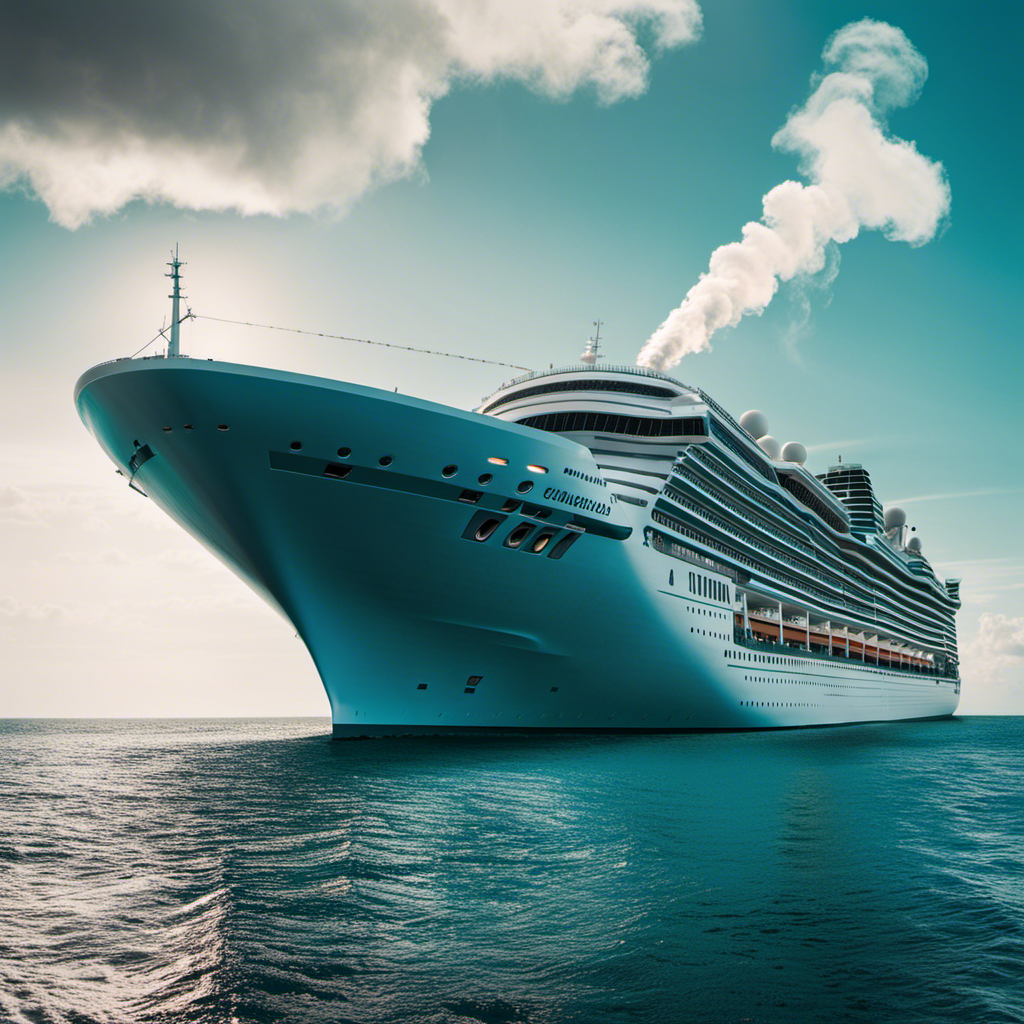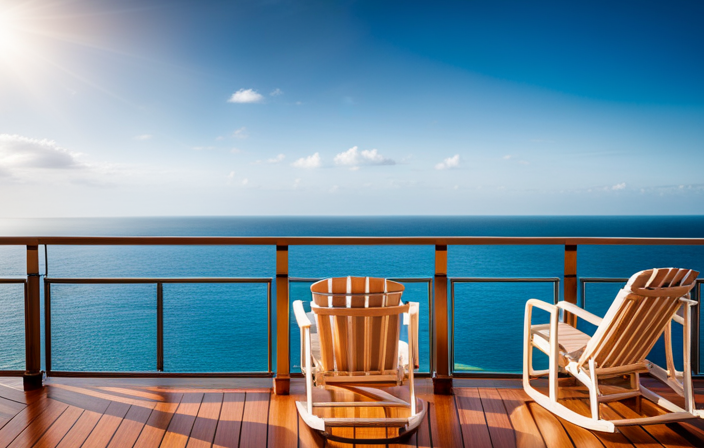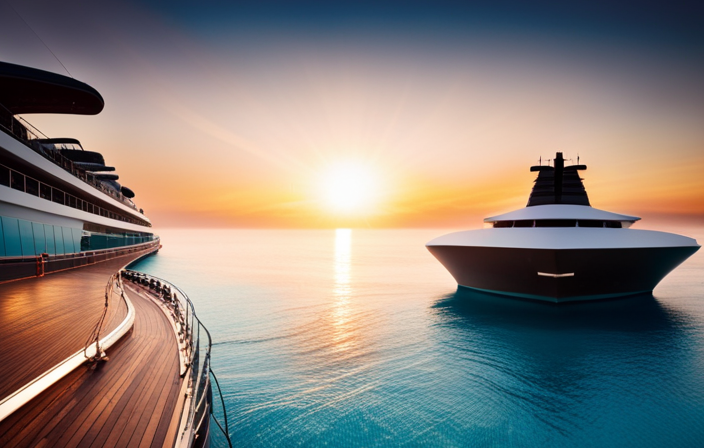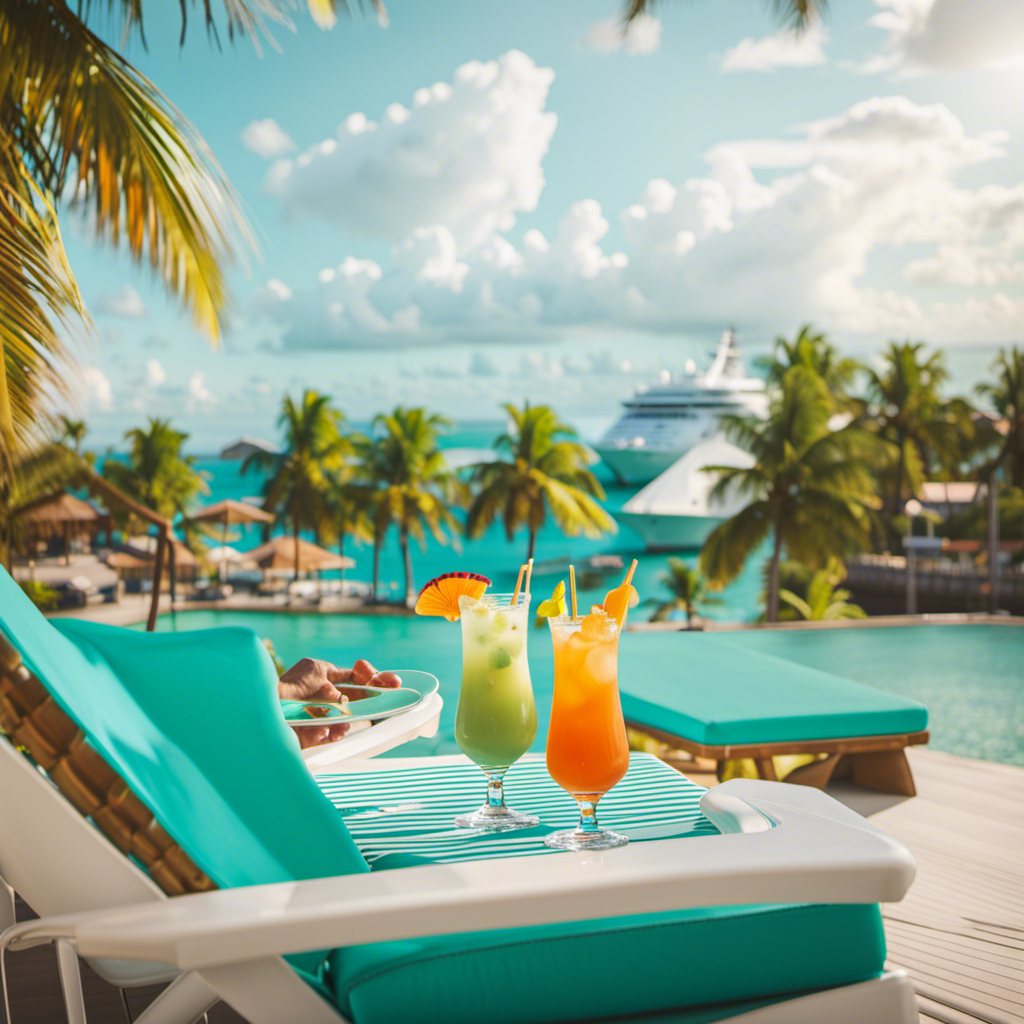It’s remarkable the amount of fuel that cruise ships burn through for every mile they journey! In this article, I’ll delve into the environmental impact of their fuel consumption and the factors that lead to it.
We’ll also explore the average fuel consumption rates for different types of cruise ships and discuss strategies for reducing their thirst for fuel.
And let’s not forget about the cost of fuel in the cruise ship industry and the exciting future innovations in fuel efficiency.
Get ready to be amazed by the numbers and possibilities!
Key Takeaways
- Cruise ships consume a significant amount of fuel, leading to high carbon emissions and air pollution.
- Environmental regulations aim to minimize the negative impact of fuel consumption, such as sulfur emission standards and wastewater discharge regulations.
- Engine efficiency and design, as well as travel speed and itinerary choices, are factors that influence fuel consumption.
- Future innovations in cruise ship fuel efficiency, such as hybrid power systems and improved hull design, can lead to significant fuel savings and a reduction in environmental impact.
The Environmental Impact of Cruise Ship Fuel Consumption
You might be wondering about the environmental impact of cruise ship fuel consumption. Cruise ships are known to consume a significant amount of fuel, resulting in high carbon emissions. These emissions contribute to air pollution and climate change, impacting both human health and the environment.
To mitigate these effects, there are environmental regulations in place to limit cruise ship emissions. The International Maritime Organization (IMO) has established standards for sulfur emissions, requiring ships to use low-sulfur fuel or install exhaust gas cleaning systems. Additionally, there are regulations regarding the discharge of wastewater and the treatment of sewage onboard. These regulations aim to minimize the negative environmental impact of cruise ship operations.
Understanding the environmental impact is crucial when considering the factors influencing fuel consumption in cruise ships.
Factors Influencing Fuel Consumption in Cruise Ships
When it comes to fuel consumption in cruise ships, there are several key factors that play a significant role.
One of these factors is engine efficiency and design. The type of engine used and how efficiently it converts fuel into propulsion power can greatly impact fuel consumption.
Additionally, the speed at which a cruise ship travels and the itinerary choices made by the ship’s operators can also affect fuel consumption. Higher speeds and longer distances can require more fuel.
These factors, engine efficiency and design, as well as travel speed and itinerary choices, all contribute to the overall fuel consumption of cruise ships.
Engine Efficiency and Design
To maximize engine efficiency and reduce fuel consumption, cruise ships employ advanced design techniques. Engine performance plays a crucial role in achieving optimal fuel economy. Cruise ships are equipped with powerful engines that are designed to generate high levels of power while consuming minimal fuel.
These engines are carefully calibrated to operate at their peak efficiency, ensuring that fuel is used as efficiently as possible. Additionally, cruise ship engines utilize technologies such as turbocharging and waste heat recovery systems to further enhance fuel efficiency. By employing these advanced design techniques, cruise ships are able to minimize their fuel consumption and reduce their environmental impact.
Now, let’s explore how speed and itinerary choices also contribute to the overall fuel usage of cruise ships.
Speed and Itinerary Choices
Speed and itinerary choices greatly impact the overall fuel efficiency of cruise ships. When it comes to cruise ship speed, slower speeds result in lower fuel consumption. This is because a slower speed allows the ship to use less power, reducing the amount of fuel needed.
Additionally, cruise ship route selection plays a crucial role in fuel efficiency. By choosing routes with favorable currents and winds, ships can take advantage of natural forces to reduce fuel consumption. Furthermore, selecting routes that minimize the distance traveled can also contribute to fuel savings.
These factors, combined with efficient engine design and operation, can lead to significant fuel savings for cruise ships.
Now let’s explore the average fuel consumption rates for different types of cruise ships.
Average Fuel Consumption Rates for Different Types of Cruise Ships
When comparing the fuel efficiency of different types of cruise ships, it’s essential to consider various factors that can affect fuel consumption.
These factors include the ship’s size, weight, design, and engine efficiency.
By analyzing these variables, we can gain a comprehensive understanding of the average fuel consumption rates for different types of cruise ships.
This analysis allows us to identify the key factors that contribute to their efficiency or inefficiency.
Fuel Efficiency Comparison
You can compare the fuel efficiency of different cruise ships. By analyzing their fuel consumption rates, we can identify potential improvements to increase efficiency. Below is a comparison table showcasing the average fuel consumption rates of five different cruise ships:
| Cruise Ship | Fuel Consumption Rate (gallons/mile) |
|---|---|
| Ship A | 0.35 |
| Ship B | 0.42 |
| Ship C | 0.38 |
| Ship D | 0.41 |
| Ship E | 0.37 |
From the table, we can observe that Ship A has the highest fuel efficiency with a consumption rate of 0.35 gallons per mile, while Ship B has the lowest efficiency with a rate of 0.42 gallons per mile. To improve fuel efficiency, ships with higher consumption rates can consider implementing measures such as optimizing engine performance, reducing weight, or utilizing alternative fuels. These improvements can help decrease fuel consumption and reduce the environmental impact of cruise ships. Moving on to the next section, let’s explore the factors that affect fuel consumption.
Factors Affecting Consumption
To optimize your fuel efficiency, it’s important to understand the various factors that can affect your consumption rate. Factors affecting maintenance costs, as well as the impact of fuel consumption on ticket prices, play a significant role in determining the overall fuel efficiency of a cruise ship. Here are some key factors to consider:
-
Vessel design and size:
The design and size of a cruise ship can greatly influence its fuel consumption. Streamlined designs and smaller vessels tend to be more fuel-efficient. -
Engine efficiency:
The type and efficiency of the engines used in cruise ships can have a significant impact on fuel consumption. Modern, fuel-efficient engines are designed to minimize fuel usage. -
Speed and route optimization:
The speed at which a cruise ship travels and the efficiency of its route planning can affect fuel consumption. Slower speeds and optimized routes can help reduce fuel usage.
Understanding these factors is crucial in implementing strategies for reducing fuel consumption in cruise ships. By analyzing and addressing these factors, cruise companies can work towards more sustainable and cost-effective operations.
Strategies for Reducing Fuel Consumption in Cruise Ships
There are several strategies you can use to reduce fuel consumption in cruise ships. Implementing these strategies, however, comes with its own set of challenges.
One strategy is optimizing the ship’s speed and route planning. By carefully planning the most efficient routes and adjusting the ship’s speed, fuel consumption can be significantly reduced.
Another strategy is to invest in advanced propulsion systems and energy-efficient technologies. These technologies, such as hybrid power systems and waste heat recovery systems, can help minimize the ship’s fuel usage.
Additionally, improving hull design and using special coatings can reduce drag and improve fuel efficiency.
However, implementing these strategies may require significant investments and retrofitting of existing ships, which can be costly and time-consuming.
Despite these challenges, the cruise ship industry recognizes the importance of reducing fuel consumption to mitigate environmental impact and ensure long-term sustainability. The cost of fuel for the cruise ship industry is a major concern, and finding ways to reduce consumption is crucial for both financial and environmental reasons.
The Cost of Fuel for the Cruise Ship Industry
The cost of fuel in the cruise ship industry is a significant concern for both financial and environmental reasons. Fuel prices can have a major impact on the operating costs of cruise lines, as fuel is one of their largest expenses. The fluctuating fuel prices can make it difficult for cruise lines to budget effectively and can affect their profitability.
Additionally, the fuel supply chain can also be a challenge for the industry. Cruise ships require a large amount of fuel, and ensuring a reliable and consistent supply can be a logistical challenge. Factors such as geopolitical tensions, natural disasters, and transportation disruptions can all impact the availability and cost of fuel for cruise lines.
As a result, the industry is constantly seeking ways to mitigate these challenges and find more efficient and cost-effective solutions. Transitioning into the subsequent section about future innovations in cruise ship fuel efficiency, it is clear that finding ways to reduce fuel consumption and reliance on traditional fuels is crucial for the sustainability of the industry.
Future Innovations in Cruise Ship Fuel Efficiency
Innovations in cruise ship fuel efficiency are necessary to reduce operating costs and minimize environmental impact. As we look towards the future, it is crucial to explore new technologies and renewable energy sources to power these massive vessels.
One promising innovation is the use of liquefied natural gas (LNG) as a fuel source. LNG has the potential to significantly reduce greenhouse gas emissions compared to traditional marine fuels.
Another future technology being developed is the use of fuel cells, which convert chemical energy into electrical energy, producing zero emissions.
Additionally, advancements in hull design and propulsion systems are being explored to enhance fuel efficiency.
These innovations hold the key to a more sustainable and environmentally friendly cruise ship industry, ensuring a cleaner and greener future for our oceans.
Frequently Asked Questions
How Does the Fuel Consumption of Cruise Ships Compare to Other Modes of Transportation?
When comparing the fuel consumption of cruise ships to other modes of transportation, it’s important to consider factors such as fuel efficiency and environmental impact. These aspects play a crucial role in determining the overall sustainability of different transportation options.
Are There Any Regulations or Standards in Place to Monitor and Control the Fuel Consumption of Cruise Ships?
Regulations and monitoring systems are in place to control fuel consumption on cruise ships. These measures ensure the effectiveness of fuel consumption regulations and allow for the proper monitoring of fuel usage.
What Are the Potential Consequences of High Fuel Consumption in Cruise Ships on Marine Ecosystems?
The potential economic impacts of high fuel consumption in cruise ships include increased operating costs and higher ticket prices. Additionally, there are potential health impacts due to air and water pollution, which can harm marine ecosystems and human health.
How Do Weather Conditions Affect the Fuel Consumption of Cruise Ships?
Weather conditions can greatly impact fuel consumption on cruise ships. Strong winds and rough seas can increase resistance, causing the ship to use more fuel. Conversely, calm seas and favorable winds can improve fuel efficiency.
Are There Any Alternative Fuels Being Explored for Use in Cruise Ships to Reduce Environmental Impact?
Exploring alternative fuels is a key aspect of sustainability initiatives in the cruise ship industry. As a cruise ship operator, we are constantly researching and testing new fuel options to reduce our environmental impact.
Conclusion
In conclusion, the fuel consumption of cruise ships has a significant environmental impact. On average, a cruise ship consumes around 80,000 gallons of fuel per day, which is equivalent to the fuel consumption of about 12,000 cars.
This staggering statistic highlights the need for strategies to reduce fuel consumption in the cruise ship industry. Implementing innovative technologies and practices can help mitigate the environmental consequences and ensure a sustainable future for this popular mode of travel.
Alfons is the visionary leader and driving force behind Voyager Info’s success. As the Editor in Chief, he brings a wealth of experience and an unwavering passion for travel to the helm of our cruise-centric platform.
With a lifelong fascination for exploring new horizons, Alfons discovered his love for the ocean and cruising at a young age. From sailing across pristine Caribbean waters to embarking on daring expeditions to far-flung destinations, he has amassed a treasure trove of first-hand experiences in the world of cruising.











